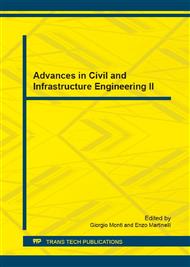p.53
p.60
p.68
p.79
p.87
p.95
p.106
p.121
p.128
Disproportionate Collapse Simulations
Abstract:
In recent years the ability to simulate and predict disproportionate collapse has seen growing interest among the scientific community. This is a challenging matter, since many authors have been dealing with the modeling of progressive collapse, and it is now well-established that such problem requires the use of many different non-standard modeling techniques together with extensive calibration. Despite the many papers in the literature, there is still a lack of methodologies tailored for the quantification of the structural robustness and its acceptable level, which clearly depends on the importance and function of the structure. Further, consideration of Performance Criteria as well as Decision Making Strategies, have to be supported by robust (but also efficient) modeling methods that have to include three-dimensional and geometrical non-linear effects. Some of the previously outlined principles about robustness will be discussed following which the authors present a methodology for taking into account that progressive collapse phenomena are governed not only by the dynamic response of the bays adjacent to the triggering event, but also by the residual plastic resources the structure conserves after the initial damage.
Info:
Periodical:
Pages:
87-94
Citation:
Online since:
July 2016
Authors:
Keywords:
Price:
Сopyright:
© 2016 Trans Tech Publications Ltd. All Rights Reserved
Share:
Citation:


